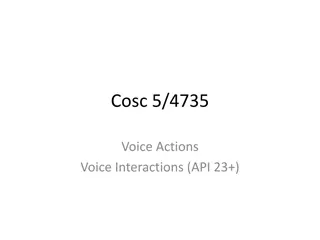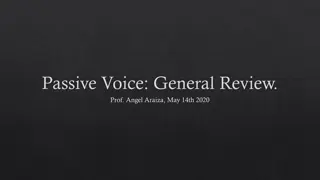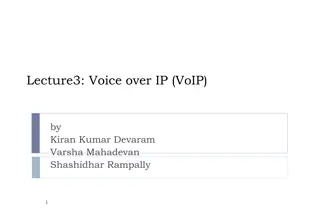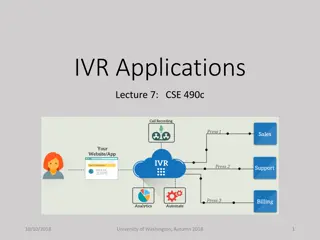Voice over IP
In the lecture about Voice over IP at Carleton University, delivered by Tony Hutchinson, a Cloud Architect/System Engineer, various topics were covered including VoIP design, network infrastructure, PBX systems, and more. Hutchinson's expertise in VoIP and network design, along with his extensive experience in the field, provided valuable insights into the evolution and challenges of VoIP technology. The agenda encompassed executive summaries, historical perspectives, business cases, service convergence, infrastructure challenges, and the impact of VoIP on modern communication systems. The lecture highlighted crucial aspects such as network impairments, encryption security, toll bypass, service convergence, and business expansion opportunities. Tony Hutchinson's expertise and the comprehensive agenda shed light on the transformative impact of VoIP technologies in the telecommunications industry.
Download Presentation

Please find below an Image/Link to download the presentation.
The content on the website is provided AS IS for your information and personal use only. It may not be sold, licensed, or shared on other websites without obtaining consent from the author.If you encounter any issues during the download, it is possible that the publisher has removed the file from their server.
You are allowed to download the files provided on this website for personal or commercial use, subject to the condition that they are used lawfully. All files are the property of their respective owners.
The content on the website is provided AS IS for your information and personal use only. It may not be sold, licensed, or shared on other websites without obtaining consent from the author.
E N D
Presentation Transcript
Voice over IP Carleton University VoIP Overview Carleton University VoIP lecture Tony Hutchinson (Cloud Architect/System Engineering) March 15th, 2018
Biographical Information Tony Hutchinson Expertise: VoIP and network design PBX Design, TDM, ISDN, Ethernet, PSTN (PRI, BRI and Analogue), EMC, Safety Telephony and data, TDM and PDH design Current Position - 1998 to Present Cloud Architect Mitel Networks (Canada) System Engineer Manager Mitel Networks (Canada) VoIP design, PBX, Hosted (Cloud) Services, Network Design Technical interface with RnD and customer facing Sales/System Engineers Previous Positions (UK) Telecom Sciences SME PBX System Engineer Philips SME ISDN PBX System Designer (for the global market) GEC Transmission and Multiplex system (analogue and digital design) Education Birmingham University (UK): Electronic and Computer Engineering (Hons.) VoIP Carleton University 2018
Agenda Executive Summary History Business Case Services Convergence Infrastructure Challenges VoIP Carleton University 2018
Executive Summary G.729 Maintaining PESQ, PSQM G.711 VAD G.726 Wideband International Sidetone Managed Network Diffserv Guarantee VPN Local CODEC MOS Bandwidth VLAN SIP H.323 Toll MPLS 2W/4W SLA Priority Ergonomics Megaco TOS Transmission Levels Echo Proprietary ISP Access Voice Quality Delay Packet Size Protocols OSI 7 Layer Features Acoustics Fixed link Signalling Traffic Overhead WAN Frame Relay Local ISP Signalling History MAN Hybrid Lots Learnt Delay Internet Infrastructure Toll Quality? Managed Lots Forgotten Not Internet Firewall Network Telephone Numbers Echo IP NAT Moves, Adds, DOS Resiliency TDM Challenges Changes Hot Desking 24/7 Geographic Independence Security E911 Power Business Case Network impairments VoIP Encryption Security? Toll Bypass Distributed Business Connectionless Jitter Buffer Packet Loss Clock Sync In- Band Data Business Expansion Services Convergence Enterprise/ Branch office TDM Backup FAX VPN Dial Tone Voice/Data CableTV Cut across geographies MODEM Two towers NY Voice Mail Hook Switch Video POS CTI IP-Trunks Soft Phone Conference WorldCom Unified Messaging Culture Traffic rates Road warrior Cost of dedicated links Teleworker 24/7 Interactive Real Internet Data World PDA integration Presentation/ Passive Telecom World Cost of infrastructure Business Applications Presence Convergence Structurd wiring Line cards Vs L2 switches of cabling Demarcation Agents Hotel Training Security Video/ Cable New Standards VoIP Carleton University 2018
Agenda Executive Summary History Business Case Services Convergence Infrastructure Challenges VoIP Carleton University 2018
History There has been much experience learnt in 100 years Some is so common place, it has been forgotten With IP some of these lessons need to be re-learnt Echo was previously just louder side-tone Added delays now affect conversation quality Network Clocks were previously well defined Data path wasn t lossy, with potential gaps in speech VoIP Carleton University 2018
Agenda Executive Summary History Business Case Services Convergence Infrastructure Challenges VoIP Carleton University 2018
Business Case So why all this interest in IP? Isn t it just another transport medium? Yes Connectionless Not constrained to a physical location Path between two user points is not pre-defined, can change dynamically Bandwidth is only consumed when needed Cost Alternative The long haul carriers (e.g. AT&T) are already carrying data traffic in their large networks (at a lower cost) So, send voice as data and pay less! Why Now? Moore s Law Cheaper Processing More readily available VoIP Carleton University 2018
Business Case So why deploy IP rather than TDM? Easier and cheaper maintenance: Integration of data and voice onto one network Consolidation of trunk access to a central SIP gateway (IP) across the business Lower operating costs: Integration of remote offices over a common corporate data network, rather than through PSTN. Single Dial Plan. Access from anywhere: Power users such as Teleworker and sales Road Warrior . Global Access Lower product costs: Integration of a voice application onto a central server, e.g. voice mail, means reduced number of devices. The remote sites no longer need their own local VM. Security, Resiliency and Availability: In NY (September 11th) the IP infrastructure kept running; the PSTN didn t Unified Communications and Integration with other (mobile) services Displacement of older (non-IP) phone systems VoIP Carleton University 2018
Business Case There are still reasons for both IP and TDM to live together Legacy devices are still going to be around (for some time) and people will still use these, e.g. FAX, remote MODEM TDM and IP are now equally important transition to IP is occurring Many businesses are IP only, home subscribers are mixed. Mobile and 4G/LTE is increasing VoIP uptake. 5G will continue to drive this forwards 4G/LTE is IP only Wikipedia (2017) 7.0B mobile phones 7.3B people Country Ranking 1. China (+1) 2. India (-1) 3. USA (=) 37. Canada (=) %LTE Subscriptions Courtesy: Ericsson VoIP Carleton University 2018
Business Case In the Business PBX space two main tiers are emerging: 1. On-Premise & Private Hosted 2. Public Cloud Hosted For 2018 expected revenues are: $88B for overall VoIP and UC, including $12B for Public Cloud Hosted Cloud Hosting offers opportunity for VoIP without local boxes . OPEX, rental model Increasing Integration of services (UC) with other (mobile) data devices. Mobility - anywhere Wireless connections and new data modes allow IP connections to be provisioned much easier in countries where it has traditionally been difficult to provide standard telephone cables and wires. VoIP Carleton University 2018
Agenda Executive Summary History Business Case Services/Content Convergence Infrastructure Challenges VoIP Carleton University 2018
Services/Content What services are people looking for? Basic hook-switch and dial tone Call handling features, transfer, etc. Advance features such as call centres, agents, skill based routing Remote location, e.g. Teleworker, Remote Agent Networking between sites and Virtual Private Networks Voice recognition Business Process Improvements and integration, e.g. Google, SalesForce Unified Communications and Collaboration (UCC), Business to Business (B2B) Improved mobility, BYOD and use of Smart Phones anywhere (in/out of office) VoIP Carleton University 2018
Services/Content We started circa 2000 with V1 applications Biggest features were Toll Bypass and Networking Today, V2 and V3 applications are normal practice. Affect on business Remote workers and Applications that don t require access to the office Remote ACD, help desks, etc Road Warriors - Sales Service Personnel Mobility integration Common access number for all connections Unified Communications: Voice, Video, Application collaboration Business workflow and collaboration VoIP Carleton University 2018
Services/Content Unified Communications (UCC) ACD and workflow call routing Globally Accessible Service is handled by same agent to give more personalized service E-mail, V-Mail, video, chat, collaboration Agents located globally - full language support Presence and call routing Redirection of calls based on time, availability and caller to different end points Speech Recognition Redirection of calls based on spoken words Integration with multiple call routing applications, Microsoft, e.g. Skype Active Directory and E-Business Workforce is distributed, and mobile. Fixed Mobile Convergence Customer Relationship Management tools One number - able to pick up calls at desk and mobile, or alternative number On phone Advertising, e.g. hotel B2B collaboration, e.g. presence sharing Switchover between mobile carrier and in- house Wireless LAN Business Process Improvement VoIP Carleton University 2018
Agenda Executive Summary History Business Case Services Convergence Infrastructure Challenges VoIP Carleton University 2018
Convergence What do we mean by convergence? Combining of different worlds Different mindsets and cultures Different set of standards Use of personal devices (Smart phone) for both business and personal use Bring Your Own Device (BYOD) And why now? Processing power is cheaper - Moore s law! Phones have more power today than early PCs PCs and phones are standard desktop tools Voice and data networks can be combined to ONE Phones can now interact directly with data devices and applications VoIP Carleton University 2018
Convergence Convergence at the network level is unseen by the user. What does the user see at the access point? Two line jacks into ONE? Add in a wireless connection ? Wifi Bluetooth 3G, 4G, LTE 5G? IP Multimedia System (IMS) Converged infrastructure Connection from anywhere From wired or wireless, mobile phones, internet Common IP infrastructure Location tracking, routing and billing Access from anywhere VoIP Carleton University 2018
Convergence PSTN, Mobile/Cell Circuit Switched $455B Four main business areas are converging Voice, TV/Video, VPN and Data Triple Play Broadcast TV - 100% users Telephony - 100% users VoIP VoDSL Internet - 80% users+ (NA) FR, ATM, Private Line Connection Oriented $18B Cable TV $75B Internet, IP Data Connectionless $18B Voice is still the biggest revenue earner Incumbents need to grow and expand Courtesy: ATM Forum Many Cable TV providers now offer IP connectivity, many also voice. New IP providers: Hosted VoIP, SIP Trunks, Video on Demand (e.g. NetFlix) Integration of Services VoIP Carleton University 2018
Convergence Long Distance PSTN e.g. AT&T SIP Trunk Gateway CO, CO, e.g. Verizon e.g. Bell SIP Trunk Gateway SIP Trunk Gateway Existing TDM Existing IP IP Network 1 IP Network 2 Peer2Peer BGP Router LAN Hosted SoftSwitch LAN Business A Business B Merging of business functions to common IP network VoIP Carleton University 2018
Agenda Executive Summary History Business Case Services Convergence Infrastructure Challenges VoIP Carleton University 2018
Infrastructure What are the building blocks of the system and how are these connected? Deployment Architectures and voice media paths Signalling Protocols Network Interconnections VoIP Carleton University 2018
Infrastructure The voice media paths and switching define the type of system. Three main types are defined: IP Enabled PBX Here a line card is simply replaced by an Ethernet card. Voice switching is done in TDM. This is not scalable and adds unnecessary delay. Hybrid PBX TDM and IP are handled equally, only traversing a gateway when IP and TDM devices need to connect. Typical in a SME (on-premise) environment IP-PBX (Hosted Private and Public Cloud Services) All switching is done in IP. TDM connections are generally only to the PSTN via external gateway, which is typically off-site. G/W Model used for Hosted services, both Private (e.g. single business) and Public (e.g. Skype) IP IP Phone Phone IP-PBX VoIP Carleton University 2018
Infrastructure Basic VoIP system building blocks Gateway between IP and TDM Media Gateway Controller Call Control Media Gateway Controller Feature Server, e.g. Voice Mail Features and Services End users Signalling Media Gateway Call Different protocols use different names, but functions are essentially the same Control/ Media Server IP PSTN Media Streaming Peer to Peer or Central Control? Central is good at resolving resource conflicts Peer to peer is resilient to network failure IP IP Phone Phone SIP can handle both aspects VoIP Carleton University 2018
Infrastructure Signalling Protocols are numerous and include: H.323 MGCP/Megaco SIP Proprietary Why so many Signalling protocols? Different starting perspectives of the requirements They all offer some advantage for different users Most are evolving as new features start to roll out VoIP Carleton University 2018
Infrastructure H.323 Overview specification and includes: H.225 - Signalling H.245 - Media streaming TCP/IP and RTP/UDP/IP One of the early protocols Standards based, uses current ISDN technology, works well for interoperability between vendors Features are basic, but well proven Well proven ground rules about interoperability Centralised call control, based on known proven techniques, call state aware Slow to evolve Difficult to scale to millions of users Central call control = single point of failure Telephone routing biased rather than at application level VoIP Carleton University 2018
Infrastructure MGCP/MEGACO MGCP was initially a proposal to IETF for a stateless gateway protocol, it has similarities to H.323, and has the ability to evolve Combined forces with ITU to create MEdia GAteway COntrol Similar to H.323 in content, but reduced messaging New standard and evolving Allows central and distributed call control access to a gateway Was thought to be the front runner with Enterprise business but little is heard Difficulties again in scaling from a global view. Different gateways need different controllers which need to intercommunicate. VoIP Carleton University 2018
Infrastructure SIP (Session Initiation Protocol), RFC2543 More Client/Server based and allowing Peer to Peer interaction. Call control can be distributed End devices need to be more intelligent than simple phones Has the ability to evolve quickly, and scale to large numbers Simple protocol, but lacks certain PBX capabilities Vendor specific options provide features Inter-vendor working is usually determined through bake-off but improving as more vendors implement agreed solutions Networking features low, but improving Open Standards through IETF, agreed by many established industry leaders Continual proposal of new features and extensions SIP Extensions to include proprietary features to make them more mainstream SIP is the Internet Phone signalling protocol of choice VoIP Carleton University 2018
Infrastructure Private Enterprise Private Cloud Infrastructure as a Service (IaaS) Public Cloud Software as a Service (SaaS) Cloud Network Cloud Network (Hosted) Cloud PBX PBX PBX Premise Migration Customer Network Customer Network Customer Network Local Management PBX on premise Traditional deployment Local Management PBX on rented servers in cloud. VPN connected Cloud Management Portal Unknown infrastructure in cloud. Public IP connected VoIP Carleton University 2018
Infrastructure Edge Firewalls Used to keep out unwanted access NAT and IPv6 NAT and ALG will not be needed Restricts flow of data both ways, including voice Any device can access any other device in both public and private address space Network Address Translation (NAT) Truly global access- one large address space Maps many internal private addresses to limited number of public IP addresses NAT is typically not application aware VoIP media and signalling may include private IP addresses in messages which will be confusing externally in public IP space NAT ALG Application Level Gateway (ALG) Stateful and knowledgeable of protocol, e.g. SIP External: Internal: Can translate private/public addresses within messages Public IP Address Space Private IP Address Space SIP ALG also known as Session Border Controller (SBC) VoIP Carleton University 2018
Infrastructure SoftSwitch SIP Trunk Gateway Private IP Private IP VoIP SIP ALG PSTN Hosted LAN Public IP Carrier/SP LAN SIP ALG Public IP Internet Border Gateway LAN Carrier2 Public IP Private IP Architecture of SIP in a large carrier deployment SIP ALG provides IPv4 NAT and firewall functions for SIP Service Provider (a.k.a. Session Border Controller (SBC)) VoIP Carleton University 2018
Infrastructure With IPv6 all devices can be addressed globally Removes need for NAT and SIP Proxies (ALG), making global connections possible For example: call control in NA, gateway in Asia, IP phone in Europe! Uptake of IPv6 is currently slow. Internet of Things (IoT) and more 4G LTE phones will drive change. But today we re still stuck with a lot of IPv4 SIP is the accepted global standard for IP media device signalling SIP and IPv6 have the potential to become disruptive technologies in displacing the current (TDM) telephone network systems Industry Trends SIP Trunks IPv6 provides everyone with a global address SPs compete on a global scale Network SP provides phones Network SP provides end-end IP SIP User Today VoIP Carleton University 2018
Agenda Executive Summary History Business Case Services Convergence Infrastructure Technical Challenges VoIP Carleton University 2018
Technical Challenges: Many! There are many Voice Quality Delay, packet loss, echo, delay, jitter, clock slip, Tones In-band DTMF, FAX, MODEMS Packet Size Voice CODEC Bandwidth Security Rules and Regulations, including E911 IP address space VoIP Carleton University 2018
Technical Challenges: Voice Quality Metrics To a User - It s a Phone! Voice Quality Metrics Ps 35 SLR Nfor Nc A Toll Quality 8 -64 -70 0 Ds RLR Nfo 3 2 -62 Mean Opinion Score (MOS) of 4.0 or better OLR Nos Ie 10 -75 0 E-Model with R=80 or better STMR 18 Pr RLR Nor No 35 2 -84 -61 Output based on many inputs: Dr LSTR Pre OLR SLR Ro 3 21 35 10 8 95 Delay STMR 18 No -61 OLR T RLR Iolr Levels 10 150 2 0.44 EL TELR Ist Is Echo 54 64 2.20 2.64 T Ro Iq 150 95 0.00 Background noise STMR 18 Qdu 1 CODEC Ist Idte Id R 2.20 3.54 4.55 88 R=88 b26 WEPL 110 Idle 0.84 b28 Tr Ta Idd 300 150 0.16 c61 Continued Voice Quality is expected Ro 95 VoIP Carleton University 2018
Technical Challenges: VQ - Delay and Loss Voice Quality End to end delays of ~150ms are tolerable with good echo cancellation techniques G.711 - QoS Versus Delay and % Packet Loss 1% packet loss with good Packet Loss Concealment is also tolerable 90 Satisfied Far End Echo Loss 80 Jitter only becomes significant when it results in packet loss 55 dB Some User Dissatisfied 70 0% PL 1% PL 2% PL 3% PL 1% PLC 2% PLC 3% PLC Jitter buffer balance between adding delay and introducing packet loss QoS R Value Many Users Dissatisfied 60 Nearly All Users Dissatisfied 50 Not Recommended 40 0 100 200 300 400 500 Total One Way Delay (ms) Note: Above 200ms an additional 20ms delay is worse than 1% packet loss with PLC. Some Delay is tolerable VoIP Carleton University 2018
Technical Challenges: Voice Quality - Echo IP-Phone End Point Echo Canceller Jitter Buffer and Packet Loss Concealment De- Speech Decode D / A packetisation ECHO Echo Prediction Acoustic Coupling IP Speech Encode NLP Packetisation A / D Echo is always present, even in TDM. Delays in IP makes this more noticeable IP Gateway End Point Echo Canceller Jitter Buffer and Packet Loss Concealment De- Speech Decode D / A packetisation ECHO Echo Prediction IP Speech Encode NLP Packetisation A / D Electrical Coupling Control of Echo is important VoIP Carleton University 2018
Technical Challenges: Voice Quality - Delay Let s look at where delay occurs Fixed Delays in CODECs and filters Packet size delays to build a packet Jitter Buffer Network (which also introduces jitter) End to End Delay = 79ms, but with 10ms jitter (router) 3ms 2ms 1-10ms 2ms 2ms 20ms 40ms Packet Creation Jitter Buffer CODEC Filters L2 Router Queue L2 CODEC Filters Switch Switch 40ms 20ms Jitter Buffer Packet Creation 2ms 2ms 1-10ms 2ms 3ms Network Control of Delay is important VoIP Carleton University 2018
Technical Challenges: Network Jitter Where does jitter come from? Serialization delay: Waiting for larger packets to transfer Lack of Priority means all data is treated equally - First in First out Apply priority queues for voice and set MTU to cut large packets Voice 1 Voice 2 Voice 3 Voice 1 Voice 2 Voice 3 Input Data Voice 1 Voice 2 Voice 3 Data Voice 1 O/P w/o MTU Delay x ms Priority mechanism to get voice into gap first Voice 1 Voice 2 Voice 3 Data1 Data2 Voice 1 Voice 2 Voice 3 Data3 O/P with MTU MTU Breaks up large packets Use QoS settings to prioritize voice and minimize jitter VoIP Carleton University 2018
Technical Challenges: Network Jitter Removal of jitter Voice CODECs run at a constant rate Packet Arrival Too much or too little will result in a gap Small gaps in voice are not discernable <60ms Small gaps in tones are discernable Buffer Fill Jitter Buffer needed = Leaky Bucket Jitter Range Packet Loss Concealment hides loss Jitter Buffer = Leaky Bucket Fill gaps with noise, silence PLC Hides lost packets Remove data in fixed size, during silence VoIP Carleton University 2018
Technical Challenges: Clock Slip Clock Slip The CODEC at each end may run at 64kbits/s, but they have a tolerance No clock synchronization, therefore need to add or drop data Example of packet drop due to slip Suppose two device, each at 50ppm (TDM tolerance) That s 100 bits drift in 1 million bits, or 8 bits in 80,000 bits which = 1 bit every 1.25 seconds @ 64kbits/s, or 1 packet (160 bytes) every 3 minutes, 20 seconds Clock slip buffer needs to consider this drift up and down Often, slip correction is included with jitter buffer control to minimize media delays and complexity of multiple buffers Fast Clock Slow Clock Clock Slip Clock Slip needs to be considered VoIP Carleton University 2018
Technical Challenges: Transmitting Tones Transferring tones is problematic if the jitter buffer discards A DTMF tone need only be 75ms long. A packet loss of 20ms is significant, results in misdialed digits. Convert tones to signalling packet (RFC4733) and regenerate at edge (if needed) DTMF IP Network RFC4733 RFC4733 ensures DTMF tones are transferred correctly VoIP Carleton University 2018
Technical Challenges: FAX and Modem In band tone transmission Other devices use in band tones, such as: FAX and MODEM FAX will work, but only under very controlled network conditions, such as packet loss MODEMs will work, but again under controlled conditions such as echo cancellation Alternative CODEC for FAX is T.38 (and less often T.37) Alternative CODEC for MODEM is V.150 V.150 complexity has resulted in little enthusiasm to include this in gateways. Limited (proprietary) solutions are available. IoT are likely to replace current slow speed telemetry MODEMs FAX and MODEM need alternative CODECs VoIP Carleton University 2018
Technical Challenges: Packet Size How big a packet should be used? Packet Rate Use Advantages Disadvantages 10ms High speed network Low latency High Bandwidth and packet rate, not all CODECs work 20ms Mixed network, including WAN Acceptable latency, minimum rate for more complex codecs Reasonable bandwidth usage 30ms Wireless access Reduced packet rate Increased latency, not all CODECs work 40-60ms Lower speed links, satellite Reduced bandwidth Increased latency, reduced end user quality of use experience 20ms Packets - Good Compromise VoIP Carleton University 2018
Technical Challenges: CODEC So many CODECs, which one to choose? CODEC Type Voice Quality Network Impact G.711 The Standard Base CODEC. Good voice quality. PSTN compatible High Bandwidth, for voice. G.726 (Delta Modulation) Good Voice Quality Limited bandwidth reduction. Poor return on processing investment G.729, G.729a (Compression) Acceptable voice quality Much reduced bandwidth. Good for WAN access and wireless. Good return on processing investment G.729b (Compression + Silence suppression) Reduced voice quality. Silence detection and switching causes issues Potential for further reduced bandwidth doesn t materialize. Bandwidth must still be provisioned, even if not used. G.722, G.722.1 (Wideband) Much improved voice quality (8kHz) over G.711. Good user experience Reduced bandwidth compared to G.711. Good return on processing investment. Others.. Improved voice quality Bandwidth uncertainty Balance of Voice Quality and Bandwidth usage VoIP Carleton University 2018
Technical Challenges: Bandwidth How much bandwidth needed? Payload G.711: 160 Bytes (64kbps) G.722.1: 80 Bytes (32kbps) G.729: 20 Bytes (8kbps) Plus Overhead: RTP, UDP, IP, MAC and Ethernet + inter-packet gaps LAN Bandwidth (Ethernet) G.711 ~ 100kbits/s G.722.1 ~ 65kbits/s G.729 ~ 40kbits/s VoIP Carleton University 2018
The Challenges: Security Security: Becoming more important, especially for hosted deployments Becoming regulated with heavy fines for failures An attack can disrupt or even destroy a business Ever changing attack theatre Firewalls are no longer enough DDoS, floods, etc. Intrusion Detections Systems Intrusion Prevention System Application Specific firewalls Zero Day Malware attacks Sandboxes Ransomware Security Incident and Event Manager (SIEM) to look for trends and patterns of attack and raise alarms, as well as providing signature updates VoIP Carleton University 2018
The Challenges: Rules and Regulations Emergency Location (E911) Emergency Location (E911) requires that a person making an emergency call can be physically located within a pre-defined area IP phones can move and be located globally These requirements are potentially in conflict New global standards and regulations are evolving to maintain this capability IETF-ECRIT : Framework for Emergency Calling using Internet Multimedia CALEA Call Tracing, Malicious call handling Wire-tapping Charging for services Who pays? The Internet is free But, is it? Local and Global rules need to be applied VoIP Carleton University 2018
The Challenges: IPv6 IPv4 Public Address The current public address range has run out! IPv4 Sold Main users are NA and Europe Insufficient for ROW Exhaustion IANA Jan 2011 Regional Internet Regions: April 2011 Increasing IPv4 NAT complexity IPv6 Public Address Driver: 3G/4G wireless, internet connected appliances Already being deployed in a number of countries IPv6 is here! IPv4 has run out VoIP Carleton University 2018
Finale VoIP is mainstream Mobility and Unified Communications and Collaboration Business Process Improvements Technical challenges for voice quality are being overcome and improved upon The large Telecos are changing to embrace the IP changes. IMS and 4G/LTE mobile networks are extending connection from anywhere . IP network access is becoming ubiquitous, especially with wireless hotspots, e.g. WiFi SIP is the preferred communication method, and feature interaction between vendors is improving Many new service providers are appearing in the market place and consolidations are taking place Integration with other cloud services is increasing along with improved business workflow improvements. IPv6 is being implemented to provide truly global communications Thank You VoIP Carleton University 2018
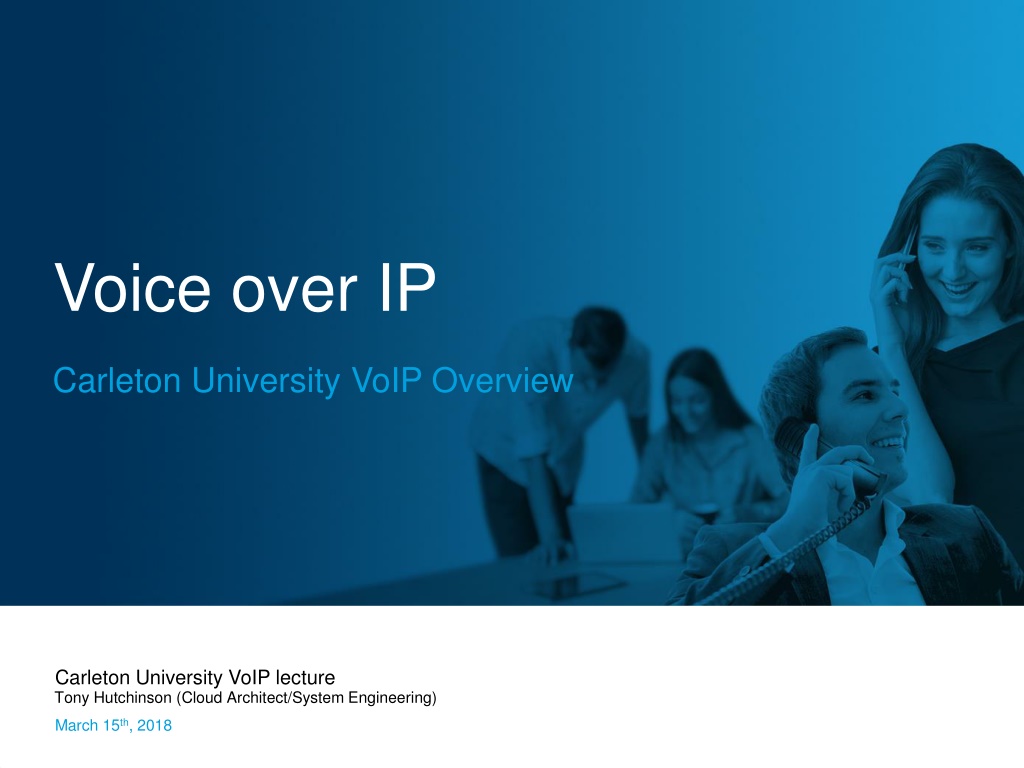
 undefined
undefined
















